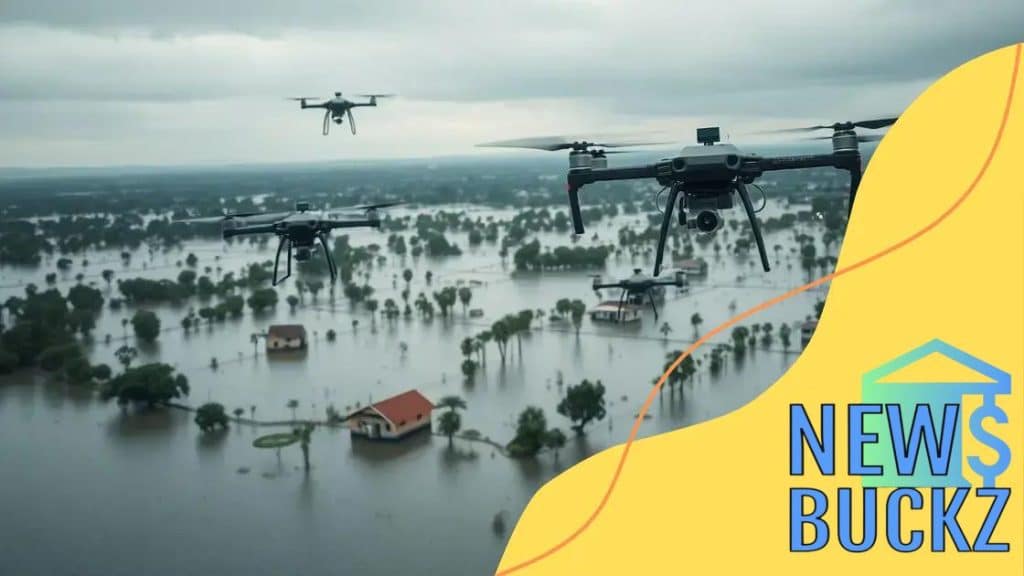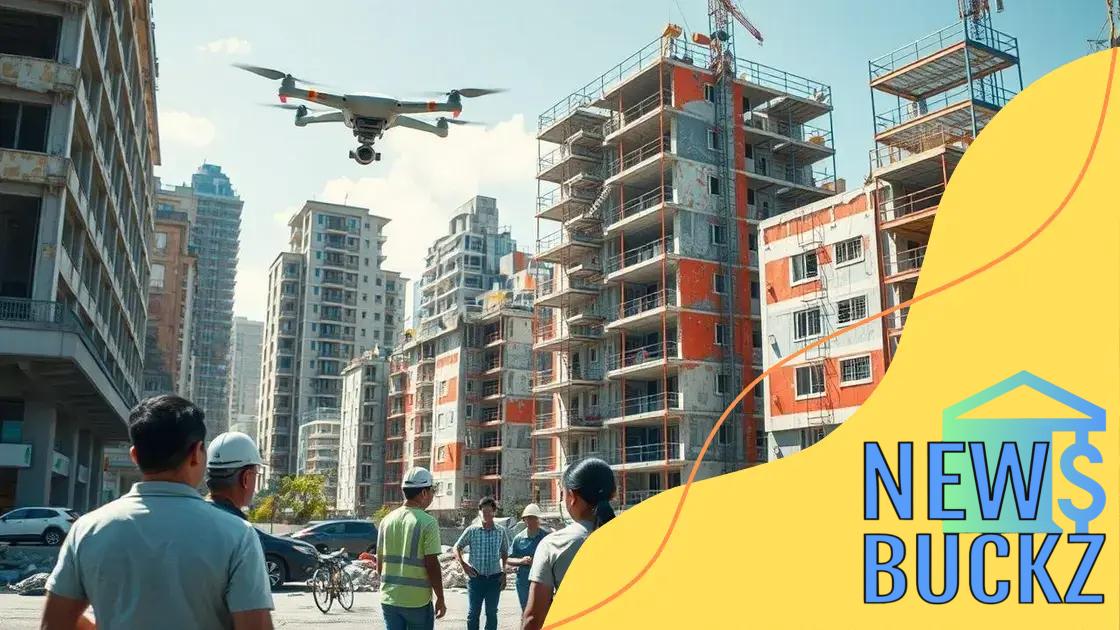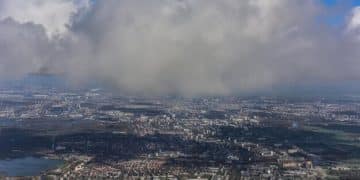Technology’s role in mitigating the impact of natural disasters

Anúncios
Technology’s role in mitigating the impact of natural disasters includes utilizing drones for rapid assessments, AI for predictive analytics, and mobile apps to enhance community preparedness and resource sharing.
Technology’s role in mitigating the impact of natural disasters is more important than ever. Have you ever wondered how innovative tools can save lives and resources during crises? Let’s explore the incredible advancements that make a difference.
Anúncios
Innovations in disaster monitoring and early warning systems
Innovations in disaster monitoring and early warning systems have revolutionized how we respond to natural disasters. These technologies play a crucial role in saving lives by providing timely information. They allow communities to prepare and respond effectively to imminent threats.
Key Components of Monitoring Systems
Modern monitoring systems utilize various technologies to detect natural disasters in real-time. For instance, satellites monitor weather patterns, while seismic sensors track earthquakes. This integration ensures that information reaches relevant authorities quickly.
- Satellite imagery for real-time weather assessment
- Ground sensors to detect seismic activity
- Automated alerts sent to mobile devices
- Data integration from multiple sources for accuracy
Another significant advancement is the use of machine learning algorithms. These algorithms analyze historical data to predict future events more accurately. They can identify patterns that humans might miss, making disaster predictions more reliable.
Anúncios
The Role of Community Engagement
Community involvement is essential in effective disaster monitoring. Awareness programs can educate residents on how to respond to alerts. This knowledge can significantly reduce panic and confusion during a crisis.
Public platforms also enable citizens to contribute data. By reporting local conditions, they help improve the accuracy of monitoring systems. These collaborations between technology and the community lead to more resilient societies.
Furthermore, mobile applications play a vital role in this ecosystem. They provide users with real-time updates and emergency protocols. These tools are indispensable during evacuations or shelter-in-place orders.
Future Directions
As technology evolves, so do the possibilities for disaster monitoring. Innovations like drone technology and advanced AI models will enhance our ability to respond to natural disasters. Drones can access hard-to-reach areas post-disaster, helping with damage assessments and search-and-rescue operations.
Investing in these technologies is critical for minimizing the impact of future disasters. The blend of advanced monitoring systems and active community participation is the key to a proactive approach in disaster management.
The impact of drones and AI in disaster response
The impact of drones and AI in disaster response has been transformative in recent years. With advancements in technology, these tools provide quick and effective solutions during emergencies.
Using Drones for Rapid Assessments
Drones are essential for quickly evaluating disaster areas. They can capture high-resolution images and videos, providing real-time data that ground teams cannot access immediately. This information allows responders to understand the situation better and allocate resources more efficiently.
- Cost-effective surveillance of large areas
- Detailed mapping of affected regions
- Ability to reach inaccessible or dangerous locations
- Faster assessment of damage and needs
Through this capability, drones significantly enhance situational awareness. This awareness is vital for making informed decisions on where to send help first.
The Role of AI in Data Analysis
Artificial Intelligence complements the use of drones by analyzing the collected data. AI can quickly sift through vast amounts of information to identify patterns and predict future damages. By automating these processes, human responders can focus on strategic planning and execution of response efforts.
AI algorithms also play a part in resource allocation. By analyzing historical disaster response data, these systems can suggest optimal strategies and deployment of supplies to maximize efficiency.
Furthermore, integrating drones with AI can enhance communication among teams. Real-time data sharing ensures that everyone involved in the response process has access to the latest information, improving coordination and reducing response times.
Case Studies of Drones in Action
Numerous success stories illustrate how drones and AI have changed disaster response. For example, during the aftermath of recent hurricanes, drones provided rapid assessments of flooding, enabling teams to pinpoint where aid was needed the most.
Another case involved the use of drones in wildfire management. They helped create controlled burns to prevent larger fires from spreading, showcasing predictive capabilities and proactive measures.
Overall, the synergy between drones and AI leads to more effective disaster response. As advancements continue, we can expect even greater developments in how we manage the challenges posed by natural disasters.
Smart technologies for disaster recovery and rebuilding

Smart technologies for disaster recovery and rebuilding are changing how communities recover after disasters. These innovations help speed up the process and make it more efficient.
Innovative Building Materials
Recent advancements include the creation of resilient building materials designed to withstand extreme weather. Examples are reinforced concrete and self-healing materials that can repair small cracks automatically. Using these materials can reduce future damage in disasters.
- Reinforced concrete for increased durability
- Self-healing materials for long-lasting structures
- Eco-friendly options for sustainable rebuilding
- Modular construction for faster assembly
Smart materials not only enhance strength but also promote sustainability, enabling communities to rebuild better.
Data-Driven Decision Making
Data plays a vital role in recovery efforts. Advanced data analytics helps planners make informed choices about rebuilding. By analyzing damage patterns and community needs, officials can prioritize efforts effectively.
For example, data collected from past disasters allows urban planners to design infrastructure with better resilience. This approach reduces vulnerability for future incidents and enhances safety for residents.
Furthermore, utilizing geographic information systems (GIS) helps create detailed maps of affected areas. This functionality improves coordination among different recovery teams and enables efficient resource allocation.
The Role of Drones in Recovery
Drones are also significant in the recovery phase. They provide aerial views of disaster zones, helping teams assess damage quickly. By identifying the most affected buildings, rescue operations can be more targeted and effective.
Additionally, drones can transport supplies to remote or difficult-to-reach locations. This capability is crucial when traditional routes are blocked, ensuring that essential aid reaches those in need.
Community Engagement and Smart Solutions
Community engagement is crucial in disaster recovery. Using technology platforms, residents can report needs or damages directly to authorities. This data helps streamline responses and ensures that resources are allocated effectively.
Moreover, public forums and apps can keep citizens informed about recovery efforts. These technological tools empower communities and create a sense of solidarity during challenging times.
As communities rebuild, integrating smart technologies will play an essential role. By leveraging technology in disaster recovery, we can foster resilience and ensure safer futures for all.
How mobile apps are enhancing community preparedness
How mobile apps are enhancing community preparedness is an important topic in today’s fast-paced world. These apps are powerful tools that help communities prepare for natural disasters and ensure safety.
Real-Time Alerts and Notifications
Many mobile apps provide real-time alerts about impending disasters. These notifications can inform users about severe weather warnings, evacuation orders, and safety tips. By receiving timely information, residents can take necessary actions quickly to protect themselves and their families.
- Push notifications for urgent weather updates
- Location-based alerts tailored to individual needs
- Guidance on evacuation routes and safe areas
- Checklists for emergency preparedness
When communities are well-informed, they can respond more effectively to emergencies.
Community Resource Sharing
Mobile apps also foster community engagement by enabling resource sharing. Local users can post offers for supplies or help. This sharing creates a network of support and cooperation among residents.
For instance, an app might connect volunteers with people needing assistance during emergencies. This connection strengthens community ties and enhances overall preparedness.
Moreover, apps often include features that allow users to report issues like downed power lines or flooded streets. By sharing real-time information, communities can address problems more swiftly.
Educational Resources and Training
Aside from alerts, many mobile apps offer educational resources. These can include training modules, videos, and articles on disaster preparedness. Users can learn about creating emergency plans and assembling kits.
Interactive quizzes and checklists encourage participation and reinforce learning. By increasing awareness and understanding, these apps empower individuals and families to take charge of their safety.
Collaboration with Local Authorities
Many apps collaborate with local emergency management teams for better coordination. This partnership allows for a more organized response during disasters. Users can access services and resources that local authorities provide directly through the app.
Additionally, community feedback helps authorities improve preparedness strategies. By using data from mobile apps, officials can identify areas needing more resources or training.
In conclusion, mobile apps play a crucial role in enhancing community preparedness and resilience. The integration of technology in preparation empowers individuals and fosters a culture of preparedness in communities around the world.
Case studies: Success stories of technology in action
Case studies: Success stories of technology in action illustrate how technology has effectively mitigated the impacts of natural disasters. Each case provides valuable insights into how innovative solutions have transformed disaster response and recovery.
Hurricane Harvey: Drones in Action
During Hurricane Harvey, drones played a crucial role in assessing damage and delivering supplies. These unmanned aerial vehicles provided real-time aerial footage of flooded neighborhoods. This information helped emergency teams prioritize their efforts and direct resources to the hardest-hit areas.
- Rapid damage assessment with minimal risk to human responders.
- Delivery of essential supplies to isolated locations.
- Real-time data collection for efficient response planning.
The use of drones not only saved time but also ensured that aid reached those who needed it most, demonstrating the power of technology in emergency situations.
Wildfires in California: AI for Predictive Analytics
In California, AI technologies have improved wildfire management significantly. AI analyzes vast amounts of data to predict fire behavior and spread. This information allows firefighters to take proactive measures. They can set controlled burns to mitigate larger wildfires.
By using AI, authorities can also optimize resource allocation in real-time. They ensure that the right resources are deployed to areas most at risk.
Moreover, local communities are informed about potential threats, allowing residents to prepare and evacuate if necessary.
Earthquake Resilience in Japan: Advanced Monitoring Systems
Japan has implemented advanced monitoring systems that utilize a network of seismic sensors to detect earthquakes. These systems provide instantaneous alerts to residents and authorities. The quick notifications allow people to take protective actions before the shaking begins.
Furthermore, data collected from these sensors helps improve building codes and infrastructure planning. By analyzing past earthquakes, Japan’s engineers can design structures that better withstand future shocks.
Tsunami Warning Systems: Global Collaboration
After the 2004 Indian Ocean tsunami, countries realized the importance of a global tsunami warning system. Advanced technologies that include satellite monitoring and underwater sensors have been developed to detect early signs of tsunamis.
This initiative fosters collaboration among nations. Data sharing ensures timely warnings across regions, significantly reducing casualties and enhancing community resilience.
The success of these case studies highlights the critical role of technology in disaster response. As innovations continue to evolve, communities can become better prepared, respond faster, and recover more effectively from natural disasters.
In summary, technology plays a significant role in improving our response to natural disasters. From drones delivering supplies to AI predicting wildfires, each tool enhances community preparedness. Advanced warning systems help save lives, and community apps encourage engagement and resource sharing. By learning from successful case studies, we see how innovation makes a difference. As we continue to adopt new technologies, we can build stronger, more resilient societies ready to face future challenges.
FAQ – Frequently Asked Questions about Technology in Disaster Response
How do drones enhance disaster response efforts?
Drones provide real-time aerial footage for damage assessment, deliver supplies to isolated areas, and collect data for effective resource allocation.
What role does AI play in predicting natural disasters?
AI analyzes vast data sets to predict disaster behavior and resource needs, helping authorities take proactive measures ahead of time.
How can mobile apps improve community preparedness?
Mobile apps offer real-time alerts, educational resources, and platforms for resource sharing, enhancing communication and community readiness.
What are some successful case studies of technology in action?
Success stories include drone usage during Hurricane Harvey for quick assessments and AI predicting wildfire spread in California, improving responses.





